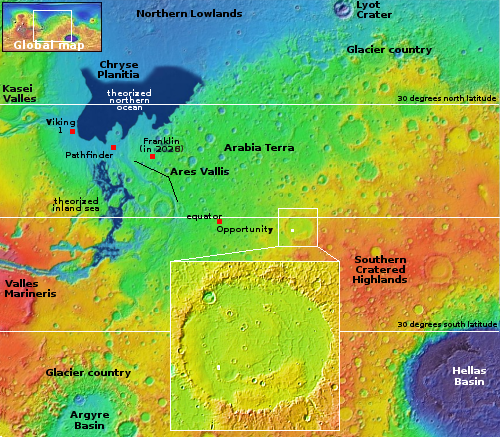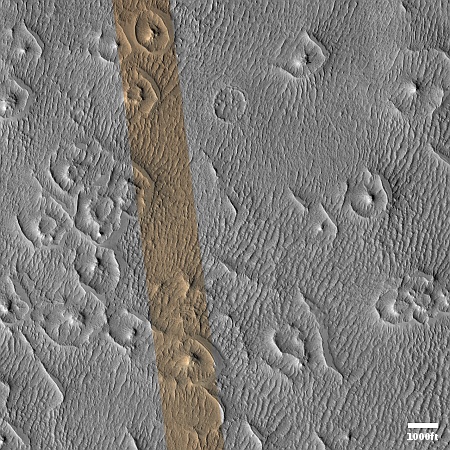Weird ring-mounds in one of Mars’ largest craters
Cool image time! The picture to the right, cropped, reduced, and sharpened to post here, was taken on August 16, 2024 by the high resolution camera on Mars Reconnaissance Orbiter (MRO). The science team labels these strange features “ring-mound landforms,” a term that has been used to describe [pdf] only vaguely similar features previously found in the Athabasca flood lava plain almost on the other side of Mars. That paper suggested that those ring mounds formed on the “thin, brittle crust of an active fluid flow” created by an explosive event. Since Athabasca is considered Mars’s most recent major flood lava event, the fluid was likely lava, which on Mars flows more quickly and thinly in the lower gravity.
Thus, in Athabasca the ring-mounds formed when a pimple of molten lava from below popped the surface.
But what about the ring mounds in the picture to the right?

The white dot on the overview map marks the location, inside 285-mile-wide Schiaparelli Crater, one of Mars’ larger cratersand also one of the oldest, its rim and interior much changed with many layers formed by Mars’s endless climatic and geological cycles, some caused by volcanic events and others by the repeated swings of the planet’s rotational tilt.
It would seem then that these ring mounds were formed shortly after impact, when much of the crater’s floor was still filled with impact melt, covered by its own thin crust. As that melt cooled, it likely caused its own convection bubbles to burst through that crust, producing these ring mounds.
Or not. Note how this patch of ring mounds is found in what looks like a secondary smaller impact crater inside Schiaparelli. Maybe the ring mounds were caused not by the main impact but by this secondary one.
Then again, the patch is itself somewhat localized. If the mounds were caused by bubbling impact melt lava from below, why only at this spot?
The mysteries of Martian geology continue to tantalize.
On Christmas Eve 1968 three Americans became the first humans to visit another world. What they did to celebrate was unexpected and profound, and will be remembered throughout all human history. Genesis: the Story of Apollo 8, Robert Zimmerman's classic history of humanity's first journey to another world, tells that story, and it is now available as both an ebook and an audiobook, both with a foreword by Valerie Anders and a new introduction by Robert Zimmerman.
The print edition can be purchased at Amazon or from any other book seller. If you want an autographed copy the price is $60 for the hardback and $45 for the paperback, plus $8 shipping for each. Go here for purchasing details. The ebook is available everywhere for $5.99 (before discount) at amazon, or direct from my ebook publisher, ebookit. If you buy it from ebookit you don't support the big tech companies and the author gets a bigger cut much sooner.
The audiobook is also available at all these vendors, and is also free with a 30-day trial membership to Audible.
"Not simply about one mission, [Genesis] is also the history of America's quest for the moon... Zimmerman has done a masterful job of tying disparate events together into a solid account of one of America's greatest human triumphs."--San Antonio Express-News
Cool image time! The picture to the right, cropped, reduced, and sharpened to post here, was taken on August 16, 2024 by the high resolution camera on Mars Reconnaissance Orbiter (MRO). The science team labels these strange features “ring-mound landforms,” a term that has been used to describe [pdf] only vaguely similar features previously found in the Athabasca flood lava plain almost on the other side of Mars. That paper suggested that those ring mounds formed on the “thin, brittle crust of an active fluid flow” created by an explosive event. Since Athabasca is considered Mars’s most recent major flood lava event, the fluid was likely lava, which on Mars flows more quickly and thinly in the lower gravity.
Thus, in Athabasca the ring-mounds formed when a pimple of molten lava from below popped the surface.
But what about the ring mounds in the picture to the right?

The white dot on the overview map marks the location, inside 285-mile-wide Schiaparelli Crater, one of Mars’ larger cratersand also one of the oldest, its rim and interior much changed with many layers formed by Mars’s endless climatic and geological cycles, some caused by volcanic events and others by the repeated swings of the planet’s rotational tilt.
It would seem then that these ring mounds were formed shortly after impact, when much of the crater’s floor was still filled with impact melt, covered by its own thin crust. As that melt cooled, it likely caused its own convection bubbles to burst through that crust, producing these ring mounds.
Or not. Note how this patch of ring mounds is found in what looks like a secondary smaller impact crater inside Schiaparelli. Maybe the ring mounds were caused not by the main impact but by this secondary one.
Then again, the patch is itself somewhat localized. If the mounds were caused by bubbling impact melt lava from below, why only at this spot?
The mysteries of Martian geology continue to tantalize.
On Christmas Eve 1968 three Americans became the first humans to visit another world. What they did to celebrate was unexpected and profound, and will be remembered throughout all human history. Genesis: the Story of Apollo 8, Robert Zimmerman's classic history of humanity's first journey to another world, tells that story, and it is now available as both an ebook and an audiobook, both with a foreword by Valerie Anders and a new introduction by Robert Zimmerman.
The print edition can be purchased at Amazon or from any other book seller. If you want an autographed copy the price is $60 for the hardback and $45 for the paperback, plus $8 shipping for each. Go here for purchasing details. The ebook is available everywhere for $5.99 (before discount) at amazon, or direct from my ebook publisher, ebookit. If you buy it from ebookit you don't support the big tech companies and the author gets a bigger cut much sooner.
The audiobook is also available at all these vendors, and is also free with a 30-day trial membership to Audible.
"Not simply about one mission, [Genesis] is also the history of America's quest for the moon... Zimmerman has done a masterful job of tying disparate events together into a solid account of one of America's greatest human triumphs."--San Antonio Express-News



Now it looks like a plasma discharge field, that was washed over by later tsunami that desiccated rapidly after exposure to space.